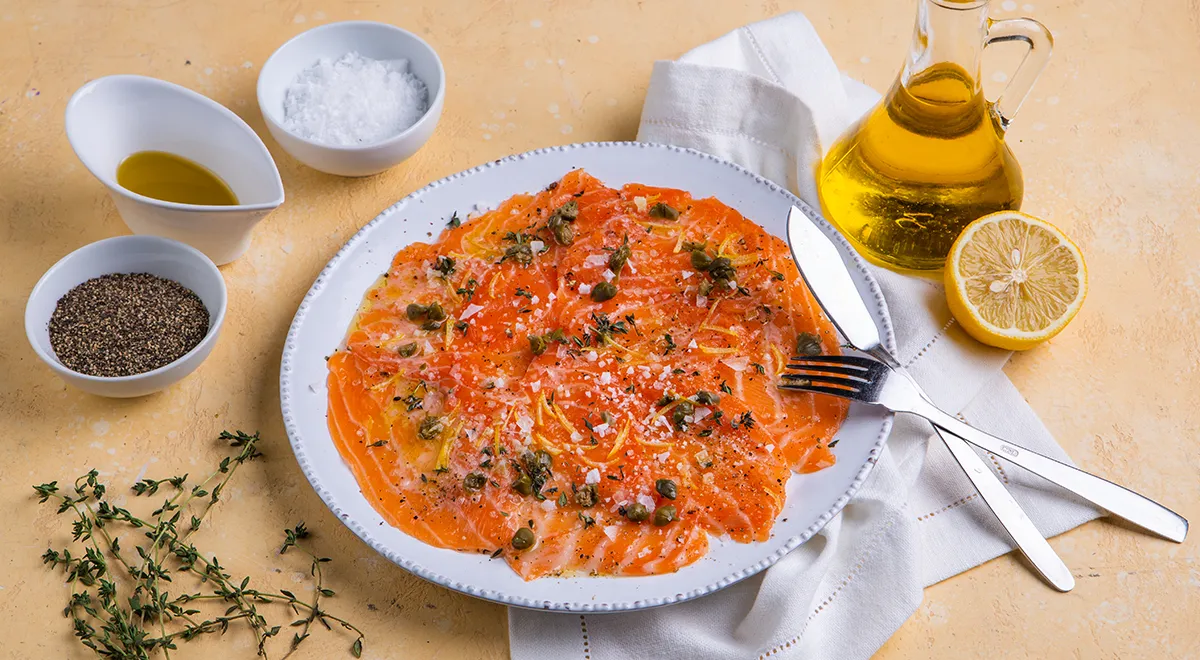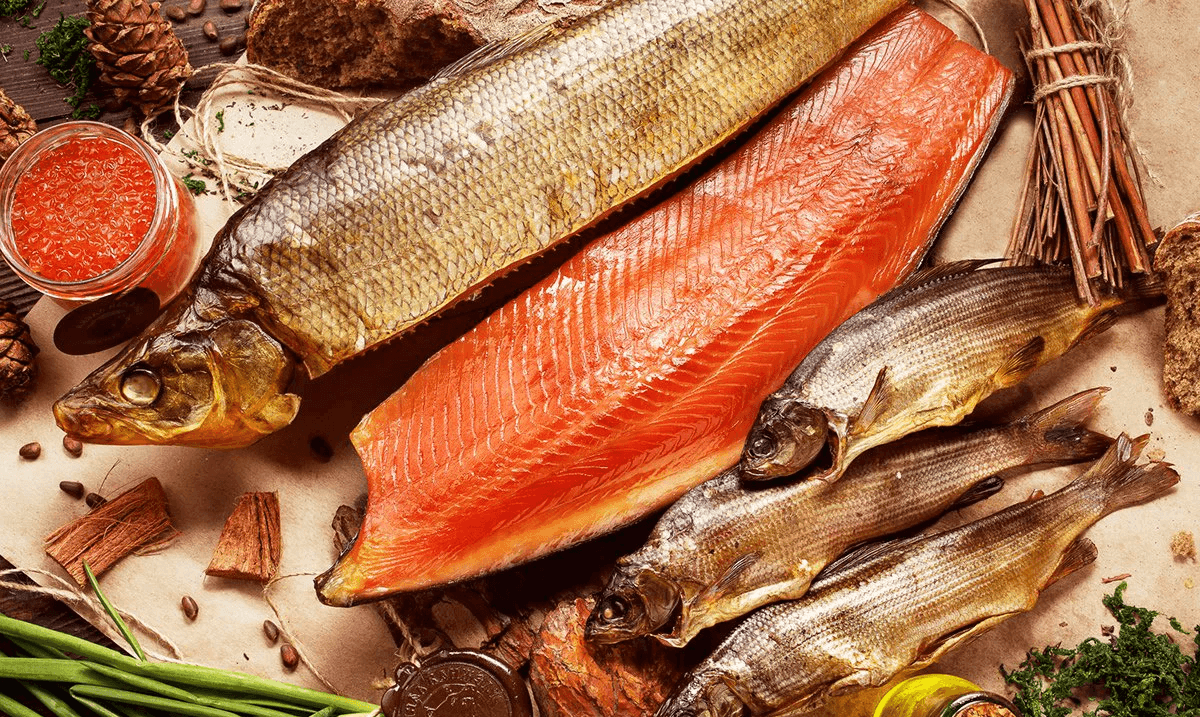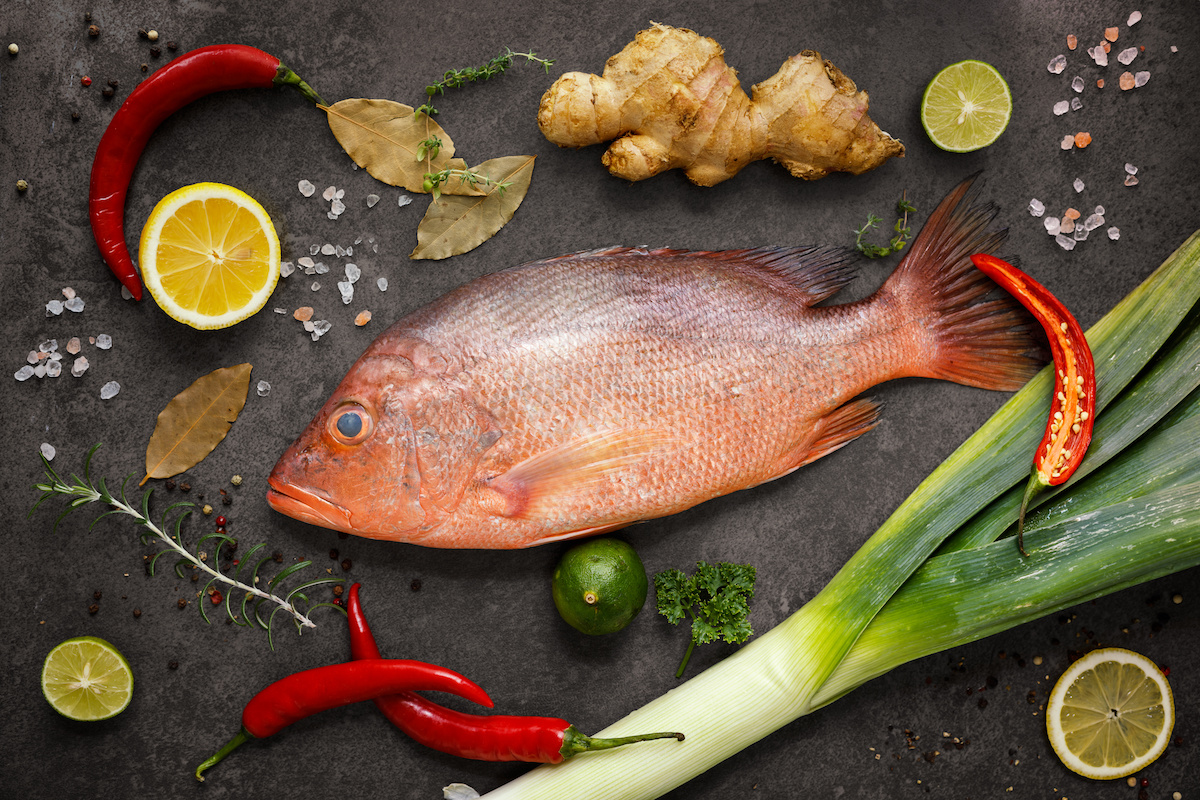Dried, salted, smoked fish — a comprehensive guide from the Berezka store
Choosing a good fish starts with a simple question: what do you want on the plate—silky, tender, or intense? Smoking, drying, and salting answer that need in different ways. Cold-smoking keeps the slice supple and adds aroma; hot-smoking gently cooks the flesh so it flakes; drying/salting concentrates flavor. Once you know the direction, it’s easier to pick the right product.
At Berezka you’ll find, side by side, traditions from Northern and Eastern Europe: sliced smiked somon , mackerel and herring for quick snacks, halibut for elegant platters, capelin and capelin roe for color and texture. In the lines below you’ll learn how to read the label (scientific name, FAO area, “wild-caught” or “aquaculture”), how to recognize quality by smell, color, and packaging, and how to choose between cold-smoked, hot-smoked, dried, or marinated depending on the dish you have in mind. We’ll answer common questions, bust a few myths, and explain why certain “processed” products can actually be more nutrient-dense per serving. The examples come from Berezka’s assortment so you can put things into practice right away.
At Berezka you’ll find them all— cold, hot, dried, marinated —together with the pieces of label information that actually matter (species, FAO area, wild-caught or aquaculture). The range is designed for easy decisions: products ready to go on the plate, properly packaged—you leave with the right fish and with little chance of getting it wrong.
What Romanians eat in the fish aisle—and what they’re missing
Romanians are rediscovering fish: first in convenient forms for home, then on “occasion” platters. The classics that are easy to use remain on top: thin-sliced smoked salmon, full-flavored smoked mackerel, herring in brine or marinated, capelin roe for spreads, and premium tinned goods—especially cod liver, which elevates a slice of rye bread into a serious snack. You’ll always find these in Berezka’s display and they fit the rhythm of a busy day.
Smoked salmon loves simplicity: rye bread with butter, a few drops of lemon, dill. Smoked mackerel turns a warm potato and red-onion salad into a satisfying lunch, and marinated herring, with pickled cucumbers and a sour-cream–mustard sauce, brings an instant Nordic vibe. When time is short, pasta with smoked salmon, sweet cream, and lemon zest gives you that sweet spot between comfort and freshness.
If you want to step out of routine, Berezka’s counter has a few interesting options. Butterfish impresses with a very fine, almost “buttery” texture—read the label and check the species’ scientific name, because different fish can appear under the same commercial name. Halibut proposes the opposite: white, firm, elegant flesh with clear flakes and a clean taste; great on platters and impeccable with a quick pan-sear. Capelin, small and tasty, excels in salads, while its roe—fine and lightly salted—adds color and texture to canapés, pasta, or rice bowls. For extra crunch, briefly fried perch tossed in a light herb-and-lemon marinade delivers a clean aroma and pleasing structure.
You can also borrow rituals from other cuisines. From the Nordic and Baltic area come gravlax—salmon rubbed with salt, sugar, and dill, matured cold—and creamy combinations with herring in sour-cream or mustard sauce. From the Iberian Peninsula, the bacalhau (salted and dried cod) tradition means patience: rehydrate for 24–48 hours, cook slowly, get tender texture and rounded flavor. From Japan, shiozake—lightly salted salmon—fits naturally into breakfasts, onigiri, or rice bowls. From Eastern Europe, layered salads with herring, potatoes, and onion remain current, as do canapés with cod liver on rye—simple, filling, and elegant.
For “premium without a big budget,” there are alternatives that keep the sense of indulgence. Mackerel and herring are oily fish with personality—satisfying intense cravings in small portions at friendly prices. Capelin brings versatility—works in salads, omelets, or spreads—and the roe adds a festive note. When you want a fine white “for a special moment,” halibut offers an elegant experience even in 100–150 g platter portions, often better value relative to how much you actually eat.
Drop by Berezka and, alongside your classic choice, pick something new. That’s how you quickly learn the differences in texture and aroma and find your favorites.
Techniques: dried, salted, smoked—what they mean and how they shape flavor
In short: salt draws out water and highlights flavor; drying pushes concentration to the max; smoke adds aroma and, depending on temperature, may or may not cook the fish. You feel the differences on the plate—in texture, depth, and how you use the product.

Salting (light/medium/heavy) works by osmosis: water leaves the fibers, salt enters, the flesh firms up, and the natural taste stands out. Light salting keeps juiciness and suits canapé slices (e.g., salmon shiozake); medium salting balances taste and texture for direct eating; heavy salting is used for long keeping or for products that are rehydrated before cooking (bacalhau). After opening, you can briefly rinse or soak if you want to soften the salt, then adjust with lemon, oil, and herbs.
Drying/dry-salting goes further: the fish loses lots of water and the aroma intensifies. Classic examples: stockfish (air-dried, no salt) and salted-dried cod (bacalhau/klippfisk). Rehydrate slowly in cold water with periodic changes, then cook gently (braise, bake, stews, or pasta). The result: firm texture, clear flakes, deep umami.
Cold-smoking means low temperature; the product isn’t heat-cooked but takes on smoke aroma and a velvety texture (sliced salmon, glossy and supple). On the label look for mentions such as “cold-smoked,” “natural smoke,” smoking time, and storage guidance.
Hot-smoking brings both smoke and full cooking. The flesh turns tender and flaky—perfect for potato salads, creamy pasta, or to eat on the spot with lemon and bread. Compared with cold-smoking, the taste is rounder and the texture more forgiving when you mix the fish with other ingredients.
Marinating (salt + acid, usually vinegar or citrus) acts in two ways: salt seasons and helps preservation; acid lightly “tightens” proteins and brings a balanced salty-tart taste. Marinated herring is a star in salads and cold snacks. Marinating doesn’t replace cooking in the classic sense; it’s a gentle transformation of texture, meant for cold consumption.
How the differences feel
- Lightly salted: supple slices, direct taste—ideal “on bread.”
- Dried/salted-dried: concentrated aroma, firm texture after rehydration; good for slow cooking.
- Cold-smoked: velvety, elegant, for serving as is.
- Hot-smoked: tender, cooked, flakes—friendly for salads and pasta.
- Marinated: salty–acid balance, freshness and “bite” in cold combinations.
Practical tip: on a mixed platter, start with cold-smoked slices (the most delicate), continue with marinated (more acidic), and finish with hot-smoked or dried-rehydrated (more intense).
How to choose quality lightly salted fish (especially when it isn’t heat-treated)
For lightly salted products (salmon, herring, mackerel, etc.), quality starts with the label. Look for the commercial name together with the scientific name—the Latin name confirms the species and removes confusion. Check origin: for sea-caught fish, the label indicates the FAO area (e.g., 27—Northeast Atlantic; 37—Mediterranean and Black Sea) and the production method (“wild-caught” or “aquaculture”).
The ingredient list should be short and clear: fish + salt (optionally a touch of sugar for balance and, sometimes, spices). For smoked fish, mentions like “natural smoke” or “cold-/hot-smoked” explain the process. Note the production date/expiry, lot, and storage conditions—signs the product has been handled properly.
For products intended for raw/near-raw consumption (e.g., thin slices of lightly salted salmon, marinated herring), look for safety information: the note “defrosted” when sold after thawing and confirmation that it was frozen preventively to control parasites (e.g., –20 °C ≥ 24 h). If you don’t find it on the package, ask at the counter.

Packaging matters: in vacuum packs, the film must be intact, with no leaks or large air bubbles. On opening, the smell should be pleasant and marine, not sharp, sour, or “old-fishy.” Color should be even, without excessive drying on the edges; to the touch, the texture should be firm yet supple—not “rubbery” and not crumbly.
For salt, “lightly salted” means balanced taste. If it feels intense after opening, rinse a slice under a trickle of cold water or soak it 1–2 minutes in ice water, then pat dry.
For price, compare per 100 g and look at the fish percentage (especially in jars in oil/brine). A fair price means consistent quality, honest weight, and a recipe without unnecessary add-ins.
How to choose quality smoked fish and dried fish
For smoked fish, the first criterion is the method. The label tells you if the product is “smoked with wood” (real smoke from controlled wood burning) or has “smoke flavor” (seasoned with extracts). If you want the traditional experience, choose the first. Then look at the cut: slices or portions with clean edges, free of dark spots or dried-out patches. For oily species (salmon, mackerel, herring), visible fat marbling is a sign of succulence; for halibut, seek white, firm flesh without dried corners. Salt should be moderate, and the smell—discreet, marine, pleasant. In general, smoked fish is served cold; if you cook it, use it as an aromatizer and add it at the end.
For dried/salted fish (cod/bacalhau, halibut, herring), check the surface: even, clean-dry, without mold or greening. A good piece is dense and firm; if it crumbles to dust or has suspicious spots, pick another. Before cooking, rehydrate in cold water—usually 12–48 hours (depending on thickness and salting level), with periodic water changes. Then cook gently—bake, braise, or brief simmer—to keep clear flakes and tender texture.
Berezka tip: for a winning platter, combine thin slices of cold-smoked salmon (silky) with chunks of hot-smoked mackerel (flaky) and add a warm salad of rehydrated bacalhau with olive oil, onion, and parsley.
Myths about smoked & dried fish
- “Smoking destroys all nutrients.” No. Smoking changes texture and may reduce some heat-sensitive vitamins, but proteins and fats remain, and aroma concentrates. Cold-smoking doesn’t cook; the product is served as is. Raw material quality and temperature control matter.
- “Only salmon is healthy.” Salmon is excellent, but herring and mackerel have a very good Omega-3 (EPA/DHA) profile and often friendlier prices. Choose by budget and flavor preference, not myths.
- “Dried fish is too salty.” At first, yes. Proper rehydration (12–48 h in cold water with periodic changes) brings it to a pleasant balance. After desalting, bacalhau becomes tender, with clear flakes and rounded taste.
- “Cod liver is ‘heavy.’” It’s a premium conserve that’s very nutritious: rich in vitamins A and D and Omega-3. The secret is portion (30–50 g as a spread) and moderate frequency. For some people (e.g., pregnant women), caution with vitamin A is wise. See our cod-liver preserves collection!
- “Smoke flavor = authentic smoking.” No. “Smoke flavor” means seasoning with extracts; “smoked with wood” indicates exposure to real smoke. Both are legal, but the sensory experience differs. If you want traditional, look for the proper mention or ask at the counter.
Why processed fish can sometimes be more nutritious
“Processed” doesn’t automatically mean “less nutritious.” With dried or salted-dried fish, water goes down and what remains is concentrated: proteins, healthy fats, and minerals show up—per 100 g—in higher amounts than in raw fish. Hence the intense taste and more visible nutrient density.
With smoked fish, the benefit comes from the marine fats already present. Well-executed smoking preserves an important share of Omega-3; since the product partly loses water, 100 g can deliver a dose comparable to—or even more concentrated than—the same amount of raw fish. Thin slices of cold-smoked salmon or chunks of hot-smoked mackerel are a quick way to work Omega-3 into the menu.
If you’re chasing Omega-3 specifically, stick with oily species: salmon, mackerel, herring. Halibut contributes a useful, but more modest amount; it’s excellent for variety, with firm texture and elegant taste.
Cod liver is a special case: a delicacy with high amounts of vitamins A and D. Use it as a spread or salad ingredient (30–50 g is usually enough) to get micronutrients without excess. For some people (e.g., pregnant women), moderation is essential due to high vitamin A.
One caution: sodium. Salted products and some smoked items can have higher salt content. Balance over the day: drink water, eat vegetables, and avoid adding salt to other meals.
Quick recipes & a “10-minute Nordic platter”
When you have good products in the fridge, dinner happens in a few moves. Below are express ideas built around Berezka’s assortment: few ingredients, forgiving technique, maximum result for minimal effort.
- Cold-smoked salmon, butter & lemon toasts (5–7 min). Thinly buttered rye, cold-smoked salmon slices, a few drops of lemon, and dill. Add thin radish rounds for crunch.
- Baltic salad with marinated herring (8–10 min). Cubed boiled potatoes (leftovers), marinated herring fillets, red onion, tart apple, pickles. Bind with sour cream/thick yogurt, a teaspoon of mustard, dill, and pepper. Serve cold with dark bread.
- Baked potatoes with hot-smoked mackerel, yogurt & horseradish (10 min). Mash baked potatoes, add flaked hot-smoked mackerel, thick yogurt, a little horseradish, scallions, and lemon. Salt comes from the mackerel.
- Pasta with smoked salmon & lemon (12 min). Boil pasta briefly; in a warm pan add sweet cream, a splash of pasta water, lemon zest and juice, pepper. Kill the heat, fold in strips of cold-smoked salmon and dill. If you have it, top with capelin roe for contrast.
- Cod-liver spread with pickles (5 min). Gently mash cod liver, add lemon, pepper, and scallions. Spread on rye and finish with a pickle or roasted pepper. Small portions.

10-minute Nordic platter (4 people). Take the fish out of the fridge 10–15 minutes ahead. On a large platter arrange: 150–200 g cold-smoked salmon (slices), 200 g hot-smoked mackerel (de-boned), 200 g marinated herring (chunks), 120 g sliced halibut (optional), 100 g capelin roe, and 1 tin of cod liver. Add 80 g soft butter, 1 small rye loaf, 2 lemons, 1 red onion, dill, capers, and pickles. Quick sauce: 2 tbsp mustard + 1 tbsp honey + 3 tbsp sour cream/yogurt + 1 tbsp lemon juice. Tasting order: cold-smoked → marinated → hot-smoked; keep the cod liver and roe for the finale. Rough counts: 75–120 g fish/person as a starter or 150–200 g if it stands in for dinner.
See Berezka’s assortment and build your mix: one “classic,” one “rich & oily,” and one delicacy—the platter is ready before the butter melts.
FAQ
How do I store smoked/lightly salted fish after opening? In the fridge at 0–4 °C, in an airtight container or re-vacuumed. Keep it away from raw foods and, as a rule, consume within 24 h (follow the package instructions). If it smells sharp or the pack “puffs,” don’t risk it.
What does “cold-smoked” vs. “hot-smoked” mean? Cold: low temperature, not cooked; you get smoke aroma and a velvety texture (supple slices). Hot: the product is cooked; the flesh turns tender and flaky—excellent for salads and pasta.
How can I tell a product is quality? Clear label (species + Latin name, FAO area, “wild-caught”/“aquaculture”), short ingredient list, intact packaging (no leaks in vacuum packs), pleasant marine smell, even color, and firm-supple texture. For raw/near-raw consumption, look for notes about preventive freezing.
Do you eat lightly salted fish as is? Usually, yes. For a milder taste, briefly rinse a slice or soak 1–2 minutes in ice water, then pat dry. For safety, check whether it was previously frozen (parasite control) and keep the cold chain.
What should I pick for good Omega-3 at a good price? Mackerel and herring, smoked/salted, offer an excellent EPA+DHA profile at friendly prices. Salmon remains a very good option; choose by budget and flavor preference.
Butterfish, halibut, capelin—what do I pair them with? Butterfish: raw/smoked with citrus, radishes, dill. Halibut: “fine white” with butter, lemon, herbs; also good with a quick grill. Capelin: quick-fried or in salads; masago adds color to canapés and pasta.
Cod liver: how do I serve it? Simply: on rye bread with onion, peppers, or pickles; a squeeze of lemon. Small portions (30–50 g) as a delicacy, especially if you eat it often.
Does drying/salting make fish too tough? It depends on technique and rehydration. With proper soaking (cold water changed periodically) and gentle cooking, the fish stays tender, with clear flakes and balanced taste.

A good choice starts with the label and is confirmed on the plate. Scientific name and FAO area, method (“wild-caught” or “aquaculture”), intact vacuum pack, and clean marine smell—these are the basics. The right technique does the rest: cold-smoked for silkiness, hot-smoked for tender flakes, dried/salted-dried for concentrated flavor, marinated for freshness.
Don’t limit yourself to salmon. Mackerel and herring bring excellent Omega-3 at friendly prices; halibut offers elegance in small portions; capelin and roe add color and texture; and cod liver—in small portions—rounds things out with fat-soluble vitamins. Choose informed and portion sensibly for tasty, balanced, budget-friendly meals.



 București
București
























